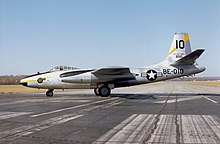North American B-45 Tornado
The North American B-45 Tornado was an early American jet-powered bomber designed and manufactured by aircraft company North American Aviation. It has the distinction of being the first operational jet bomber to enter service with the United States Air Force (USAF), as well as being the first multiengine jet bomber in the world to be refueled in midair.[2][3]
| B-45 Tornado | |
|---|---|
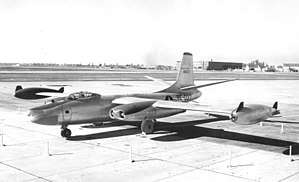 | |
| Static display of RB-45C, AF Ser. No. 48-037 | |
| Role | Strategic bomber |
| Manufacturer | North American Aviation |
| First flight | 17 March 1947 |
| Introduction | 22 April 1948 |
| Retired | 1959 |
| Status | Retired |
| Primary users | United States Air Force Royal Air Force |
| Number built | 143 |
| Unit cost |
US$1.1 million[1] (equivalent to $9.6 million today) |
The B-45 originated from a wartime initiative launched by the U.S. War Department, which sought a company to develop a jet-propelled bomber to equal those being fielded by Nazi Germany, such as the Arado Ar 234. Following a competitive review of the submissions, the War Department issued a contract to North American to develop its NA-130 proposal; on 8 September 1944, work commenced on the assembly of three prototypes. However, progress on the program was delayed by post-war cutbacks in defense expenditure, but soon regained importance due to growing tensions between America and the Soviet Union. On 2 January 1947, North American was issued with a production contract for the bomber by the USAF, which had been designated B-45A. On 24 February 1947, the first prototype performed its maiden flight.
Soon after its entry to service on 22 April 1948, early B-45 operations were troubled by technical problems, particularly low levels of engine reliability. The USAF found the type to be quite useful during the Korean War; it was used to perform both conventional bombing and aerial reconnaissance missions in this theatre. On 4 December 1950, the first successful interception of a jet bomber by a jet fighter occurred when a B-45 was shot down by a Soviet-built MiG-15 while inside Chinese airspace. During the early 1950s, a total of 40 B-45s were extensively modified so that they could be equipped with nuclear weapons; for this purpose, improvements were made to their defensive systems and the fuel tankage was expanded to increase the type's survivability and range.
In its heyday, the B-45 became an important element of the United States' defense strategy, performing the strategically-critical deterrence mission for several years during the early 1950s, after which time the Tornado was quickly superseded by the larger and more capable Boeing B-47 Stratojet. Both bomber-orientated B-45s and reconnaissance-orientated RB-45s served in quantity in the USAF's Strategic Air Command from 1950 until 1959. The USAF withdrew the last examples of the type in favour of the more advanced Convair B-58 Hustler, an early supersonic bomber. The Tornado was also adopted by the Royal Air Force (RAF) and operated from bases in Britain, where it was repeatedly used to overfly the Soviet Union on various intelligence-related missions. The RAF operated the type until it had introduced its own indigenously-developed jet bomber fleet, initially in the form of the English Electric Canberra.
Development
Background
Development of what would become the B-45 was stimulated by a request issued by the U.S. War Department during World War II. There had been a rapid emergence of various new aviation technologies throughout this period, and figures within the US were keen to keep up with the latest advances and introduce them to their own armed forces.[4] Having been alarmed by the emergence of German jet bombers, such as the Arado Ar 234, the War Department issued a request for the development and production of a new family of jet-powered bombers. During October 1944, the U.S. Army Air Forces (USAAF) issued a mission-need statement for such a bomber; on 17 November 1944, this was furthered by the release of a formal requirement, which has been claimed to have been the first requirement to be issued outside of Germany for such an aircraft.[4]
The requirements involved more than just the use of jet propulsion; the desired aircraft was to possess a gross weight of between 80,000 lb (36,287 kg) and 200,000 lb (90,718 kg), which would make it a light bomber in terms of weight for the era.[4] Aircraft manufacturer North American Aviation chose to design their own submission, which was internally designated NA-130. This bid, along with three rival proposals from other firms, would be met with orders from the government.[4] On 8 September 1944, the company commenced production of three prototypes based on its NA-130 design. According to aviation authors Bill Gunston and Peter Gilchrist, the NA-130 was viewed as being "merely a traditional bomber on to which jet engines had been fitted...the first effective jet bomber in the world, a case of the right aircraft at the right time".[4]
The end of the conflict soon resulted in the cancellation of many projects, as well as delays being imposed upon many others that had persisted. In 1946, rising tension with the Soviet Union caused the USAAF to assign a higher priority to both jet bomber development and production programmes. By mid-1946, both the XB-45 and the rival Convair XB-46 were nearing completion; while the Boeing XB-47 and Martin XB-48 were also in development, it was recognised that they were both at least two years away. Thus, the USAAF chose to evaluate the first two designs to determine which would be superior operationally. The B-45 proved a superior design; specifically, work on the project was at a more advanced stage than that of its rivals, while it was also recognised to be cheaper to develop.[4] Accordingly, on 2 January 1947, a contract for immediate production of B-45As was signed. Early plans called for the type to equip five light bomb groups and three light reconnaissance groups; despite this apparent vote of confidence, the B-45 was commonly viewed as being little more than an interim aircraft while more advanced designs, namely the B-47, were taking longer to develop.[4]
Into flight
Following the completion of the first prototype at North American's facility in Inglewood, it was delivered by road in sections to Muroc Field, where it was reassembled and readied for flight testing. On 17 March 1947, the first prototype, piloted by George Krebs and Paul Brewer, conducted the type's maiden flight.[4] Gunston and Gilchrist observe the flight test programme to have been fraught with technical issues and setbacks, the most dramatic being the total loss of the first prototype; despite these problems, due to political pressure for the programme to be delivered quickly, work continued at a frantic pace to get a production aircraft qualified for service.[5]
However, as the development and flight-testing of the rival B-47 was proving to be largely positive, news that made its own future production all but certain, the necessity and future of the B-45 became increasingly uncertain.[4] During mid-1948, the U.S. Air Staff began to openly question its value; soon afterwards, President Truman's budget restraints reduced Air Force expenditure, which drove a decision to curtail B-45 production to a total of 142 airframes. During 1950, further budget cuts compelled the Aircraft and Weapons Board to cancel 51 of the 190 aircraft on order. The cancellation of these 51 B-45s was announced on 7 January 1949.[6]
A total of 96 aircraft were delivered between February 1948 and June 1949.[7] Multiple improved models of the B-45 were proposed by North American, some of which were built and put into service. While the conceptual B-45B, which would have been equipped with a radar-guided fire control system, would never be ordered, the more advanced B-45C did secure an order.[7] This variant featured a strengthened airframe, tip tanks for greater fuel capacity, and more powerful General Electric J47-15 (or −15) turbojet engines, as well as other improvements; only 10 would be delivered from an order of 43. Perhaps the most notable variant was the RB-45C, a dedicated reconnaissance aircraft that lacked a bombing capability; 33 aircraft were delivered.[7] The B-45 was later replaced by the supersonic Convair B-58 Hustler.
Operational history
Korean War
Early operations of the B-45 were continuously plagued by engine problems which, along with numerous other minor flaws, undermined the usefulness of the bomber. However, the type regained much of its prior importance when the United States chose to enter the Korean War during 1950. In this theatre, the B-45 proved its value both as a bomber and as a reconnaissance aircraft. The mass deployment of U.S. forces to the fighting on the Korean peninsula revealed the vulnerability of North Atlantic Treaty Organization (NATO) forces in Europe to a potential Soviet attack; this realisation was a major contributing factor to the USAF's decision regarding the future of the B-45. The B-45, like most post-World War II American bombers, could carry both nuclear and conventional bombs. The progress of weapons technology had led to a great reduction in both the weight and size of nuclear weapons in the U.S. inventory, which effectively enabled smaller aircraft such as the B-45 to carry out nuclear strikes, a mission which had initially been confined to heavy bombers. Suddenly, the small fleet of B-45s once again possessed considerable value as a nuclear deterrent.
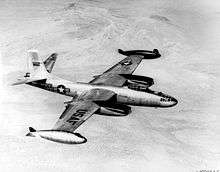
On 4 December 1950, the first successful interception of a jet bomber by a jet fighter occurred when MiG-15 pilot Aleksandr F. Andrianov shot down an RB-45C over China. Captain Charles McDonough was the only member of the four-man crew that had been able to parachute from the plane, although McDonough is believed to have died while being detained by either the Chinese or the Soviet Union. Due to the hostilities, the United States and China being on opposing sides, as well as the sensitivity typically surrounding such missions, much of the information surrounding this flight and similar intelligence activities has remained classified.[8][9]
Operation Fandango, sometimes called Operation Backbreaker, entailed modifications to the aircraft for nuclear missions. In addition, the 40 B-45s allocated to the program were equipped with a new defensive system and additional fuel tankage. Despite the magnitude of the modifications project, plus ongoing problems with the early jet engines, nuclear-capable B-45s began reaching the United Kingdom in May 1952, and deployment of the 40 aircraft was completed in mid-June. It was at about this same time that RB-45s of the 323rd Strategic Reconnaissance Squadron began to arrive in Japan to fly alongside the 91st Strategic Reconnaissance Squadron, supplementing the World War II-era piston-engine RB-29s which had proved to be easy targets for North Korean MiGs.[10] The RB-45s provided valuable intelligence throughout the remainder of the Korean War, despite the limited number of airframes available. RB-45Cs flew many daylight missions until early 1952, when they were switched to night operations after an RB-45 was almost lost to a MiG-15.[11]
Postwar
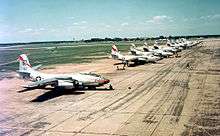
All 33 RB-45Cs built were assigned to the 91st Strategic Reconnaissance Wing's 322nd, 323rd and 324th Strategic Reconnaissance Squadrons. The RB-45C also flew several long-range reconnaissance missions over the Soviet Union during the mid-1950s. On July 29, 1952, an RB-45C made the first non-stop trans-Pacific flight, having been refueled twice by KB-29s along the way. Maj. Lou Carrington and his crew of the 91st Reconnaissance Wing flew from Alaska to Japan in 9 hrs 50 mins, winning the MacKay Trophy for their achievement. Within the 91st SRW, by 1954 the RB-45C had been replaced by the RB-47E. The phased-out RB-45Cs then went to the 19th Tactical Reconnaissance Squadron, which operated them until they were withdrawn from operational use in the spring of 1958.
By the end of the 1950s, all B-45s had been removed from active service. However, a few continued to act as test aircraft into the early 1970s.[12]
Operation Ju-jitsu
The only other nation to use the RB-45C was the United Kingdom, where it was operated by an ad hoc unit of crews largely drawn from Nos. 35 and 115 squadrons. Whilst the USAF was prohibited by the President of the United States from overflying the Soviet Union unless under a state of war, US allies closer to the European theatre of war could. In the United Kingdom, whilst successive Labour governments had refused, the return of Winston Churchill and a Conservative administration to Downing Street brought a more co-operative atmosphere to joint intelligence initiatives.
As a result, under Operation Ju-jitsu, in July 1951 four aircraft were leased to Britain from the 91st Strategic Reconnaissance Wing to form 'Special Duties Flight, Sculthorpe', commanded by Squadron Leader John Crampton. Stripped of all USAF markings and then applied with RAF markings, the four aircraft were attached to a USAF squadron based at RAF Sculthorpe, Norfolk in eastern England. The aircraft were tasked with flying deep-level reconnaissance missions over the Soviet Union to gather electronic and photographic intelligence. The Special Duties Flight conducted missions during the period 1952–54.
On April 17, 1952, three aircraft were assigned to head for Kiev from Germany, scheduled to return to Sculthorpe ten hours later. Flying at 36,000 feet (11,000 m), Crampton's aircraft was tracked by ground radar and came under antiaircraft fire. Applying full power, he immediately turned and headed for Germany, none too soon, as Soviet night fighters had been dispatched to hunt down his aircraft.[13]
Subsequent flights over the Soviet Union were carried out using English Electric Canberras under the codename Project Robin, operating at higher altitudes of around 54,000 ft (16,000 m). It was not until 1994 (under the "fifty-year rule" of the Public Records Act 1958) that the existence of the spy missions became public knowledge.
Variants
XB-45
The first flight of the XB-45 was on February 24, 1947 from Muroc Army Air Field. A total of 131 test flights were flown by the three prototype aircraft, one being destroyed early on, killing two pilots.
The USAF accepted one of the two surviving aircraft on July 30, 1948, the other on August 31. One was damaged beyond repair in an accident. The last XB-45 was delivered to Wright-Patterson Air Force Base in 1949. It proved excessively difficult to maintain and was relegated as a ground trainer.
- 3 aircraft (45-59479 – 45-59481)
B-45A
The B-45A differed from the XB-45 in having improved ejection seats and communications equipment, an E-4 automatic pilot and bombing navigation radar.
The first production B-45 flew in February 1948, and the Air Force took delivery of 22 B-45s in April 1948. Powered by J35 turbojets and not considered combat-ready, they were assigned to training duties and to conduct various test programs. The next batch were powered by the more powerful J47 turbojets. The first B-45As entered service in November 1948 with the 47th Bombardment Group, and the initial order of 96 was completed in March 1950.
The first B-45As were not equipped with bomb fire control systems or bombsights. They suffered from gyrocompass failures at high speeds, unhooked bomb shackles, engine fires, and inaccurate cockpit gauges. The AN/APQ-24 bombing and navigation radar on some B-45s was maintenance heavy, and malfunctions in the pressurization limited the altitude at which the aircraft could operate.
Fifty-five nuclear-capable B-45s arrived in the United Kingdom in 1952. These were modified with a 1,200 gal (4,542 l) fuel tank in the aft bomb bay. Despite technical problems, these were Tactical Air Command's first-line deterrent in Europe.
- 96 aircraft (47-001 – 47-097)
- B-45A-1 47-001 – 47-022 (21 aircraft)
- B-45A-5 47-023 – 47-096 (73 aircraft)
- B-45A 47-097 (static test airframe)
B-45B
The B-45B was a proposed variant of the B-45A with improved radar and fire-control systems. None were built.[14]
B-45C
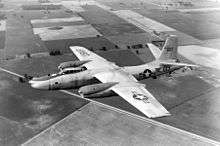
The B-45C was the first multiengine jet bomber in the world to be refueled in midair. It carried two 1,200 gal (4,542 l) wingtip fuel tanks, had a strengthened canopy, and an inflight refueling receptacle. The first B-45C was flown on May 3, 1949. Only ten were built, and the remaining 33 under construction were converted to RB-45Cs.
- Ten aircraft (48-001 – 48-010)
RB-45C
The RB-45C was the final production variant of the B-45. The bombardier's canopy was faired over and replaced with an Oblique camera system. The RB-45C carried two 214 gal (810 l) external fuel tanks, or two JATO rockets. It could carry up to 12 cameras in four positions, or a single camera with a 100 in (2.5 m) focal length lens. The RB-45C first flew in April 1950, and was delivered from June 1950 to October 1951. Thirty-eight were built, including the 33 converted from B-45Cs.[10] It was this variant that was operated (clandestinely) over the Soviet Union by the RAF "special duties" unit at RAF Sculthorpe, with the first sortie of three aircraft commanded by Squadron Leader John Crampton taking place on the night of April 17, 1952.
Operators
- Royal Air Force
- No. 35 Squadron RAF crews grouped into ad hoc units operated RB-45C variant.
- No. 115 Squadron RAF crews grouped into ad hoc units operated RB-45C variant.
|
Air Defence Command
|
Aircraft on display
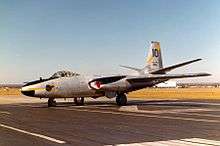
Three B-45s have survived to the present day.
- B-45A
- AF Ser. No. 47-0008 – Castle Air Museum at the former Castle AFB in Atwater, California.[18]
- B-45C
- AF Ser. No. 48-0010 – in the Cold War Hangar of the National Museum of the United States Air Force at Wright-Patterson AFB near Dayton, Ohio, The aircraft was used by Pratt & Whitney for engine testing, and was flown to the Museum in 1971.[19]

- RB-45C
- AF Ser. No. 48-0017 – Strategic Air and Space Museum in Ashland, Nebraska.[20]
Specifications (B-45A)
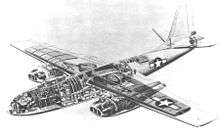
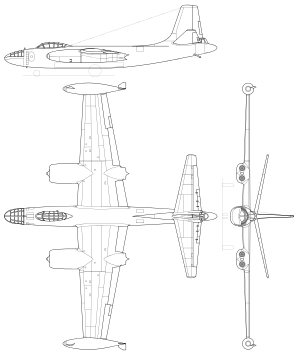
Data from U.S. Standard Aircraft Characteristics[21]
General characteristics
- Crew: 4 (Pilot, Co-Pilot, Bombardier-Navigator and Tail Gunner)
- Length: 75 ft 4 in (22.96 m)
- Wingspan: 89 ft 0 in (27.13 m)
- Height: 25 ft 2 in (7.67 m)
- Wing area: 1,175 sq ft (109.2 m2)
- Airfoil: root: NACA 66–215; tip: NACA 66–212[22]
- Empty weight: 45,694 lb (20,726 kg)
- Gross weight: 81,418 lb (36,931 kg)
- Max takeoff weight: 91,775 lb (41,628 kg)
- Powerplant: 4 × General Electric J47-GE-13 turbojet engines, 5,200 lbf (23 kN) thrust each [23]
Performance
- Maximum speed: 566 mph (911 km/h, 492 kn)
- Cruise speed: 365 mph (587 km/h, 317 kn)
- Range: 1,192 mi (1,918 km, 1,036 nmi)
- Ferry range: 2,170 mi (3,490 km, 1,890 nmi)
- Service ceiling: 46,000 ft (14,000 m)
- Rate of climb: 5,200 ft/min (26 m/s)
- Wing loading: 69.3 lb/sq ft (338 kg/m2)
- Thrust/weight: 0.26
Armament
- Guns: 2 × 0.50 in (13 mm) M3 machine guns (tail turret).
- Bombs: Up to 22,000 lb (10,000 kg)
See also
Aircraft of comparable role, configuration and era
- Boeing B-47 Stratojet
- Convair XB-46
- English Electric Canberra
- Martin XB-48
- Short Sperrin
- Douglas B-66 Destroyer/Douglas A3D Skywarrior
- Heinkel He 343
- Ilyushin Il-22
- Ilyushin Il-28
Related lists
References
Citations
- Knaack, Marcelle Size (1988). Post-World War II bombers, 1945–1973. Office of Air Force History. ISBN 0-16-002260-6.
- "North American B-45 Tornado Jet-Powered Bomber Aircraft". militaryfactory.com. Retrieved 15 September 2019.
- "B-45 — The Tornado Survivors". www.johnweeks.com. Retrieved 15 September 2019.
- Gunston and Gilchrist 1993, p. 25.
- Gunston and Gilchrist 1993, p. 26.
- Associated Press. "51-Jet Bomber Contract Killed – North American To Lay Off 2,600." The San Bernardino Daily Sun, San Bernardino, California, Saturday 8 January 1949, Volume LV. Number 112.
- Gunston and Gilchrist 1993, p. 27.
- https://web.archive.org/web/20130604071241/http://www.acig.org/artman/publish/article_315.shtml
- Burnes, Robert. "Mystery of Korean War’s Secret Air Force Mission Is Unraveled : Military: Relatives say they finally have pieced together how a U.S. spy plane and its crew members were shot down in 1950 by the Soviets." Los Angeles Times, 18 December 1994.
- FAS: RB-45
- "SpyFlight UK: RB-45C". Archived from the original on 2017-01-18. Retrieved 2007-09-26.
- Strategic Air & Space Museum: B-45C
- "Obituary: Squadron Leader John Crampton". Daily Telegraph. 1 August 2010. Retrieved 1 August 2010.
- Baugher: B-45B Archived 2007-12-15 at the Wayback Machine
- Aircraft Serial Number Search, B-45
- Maurer, Maurer, ed. (1982) [1969]. Combat Squadrons of the Air Force, World War II (PDF) (reprint ed.). Washington, DC: Office of Air Force History. ISBN 0-405-12194-6. LCCN 70605402. OCLC 72556.
- "Op Ju Jitsu". www.spyflight.co.uk.
- "B-45 Tornado/47-0008." Castle Air Museum. Retrieved: 18 December 2017.
- "North American B-45 Tornado." National Museum of the USAF. Retrieved: 11 September 2015.
- "B-45 Tornado/48-017." Strategic Air and Space Museum. Retrieved: 18 December 2017.
- "Standard Aircraft Characteristics: B-45A Tornado" (PDF). US Air Force. 9 July 1951. Retrieved 7 June 2017.
- Lednicer, David. "The Incomplete Guide to Airfoil Usage". m-selig.ae.illinois.edu. Retrieved 16 April 2019.
- first 22 produced with Allison J35 engines)"Post War B-45." Military CZ.
Bibliography
- Frederiksen, John C. (2009). The B-45 Tornado: An Operational History of the First American Jet Bomber. Jefferson, North Carolina: McFarland. ISBN 978-0-7864-4278-2.
- Gunston, Bill and Peter Gilchrist. Jet Bombers: From the Messerschmitt Me 262 to the Stealth B-2. Osprey, 1993. ISBN 1-85532-258-7.
External links
| Wikimedia Commons has media related to North American B-45 Tornado. |
